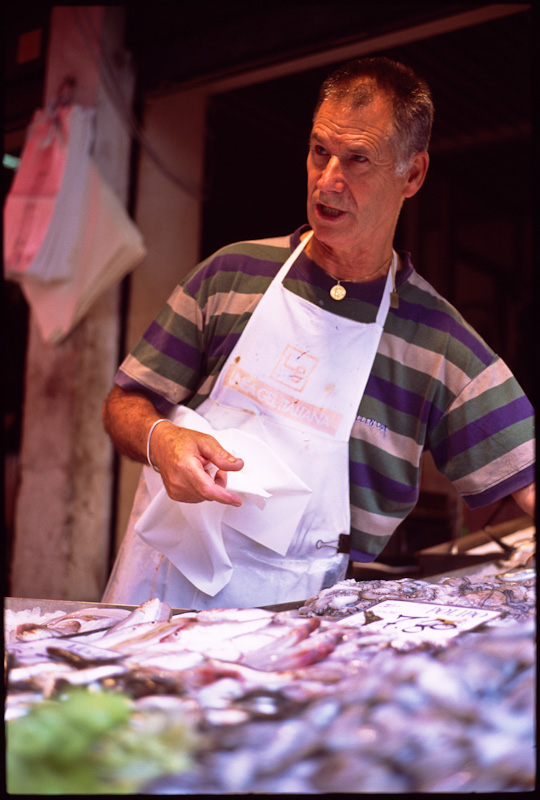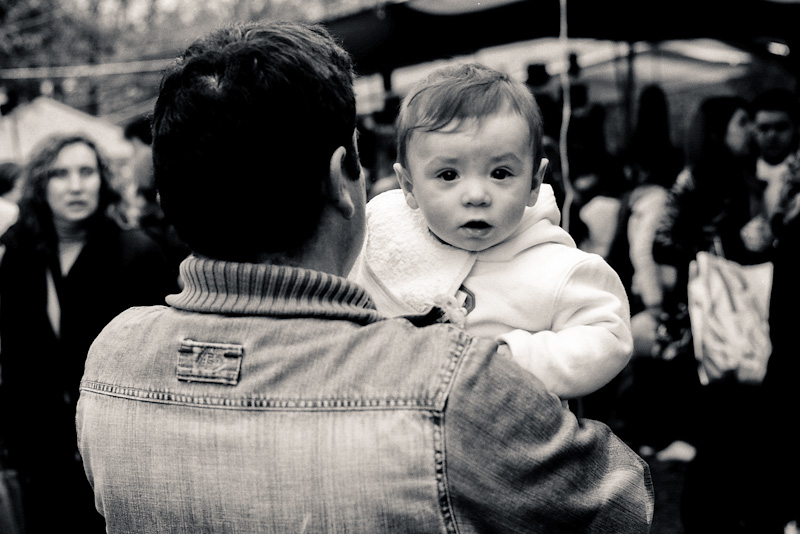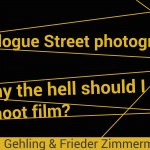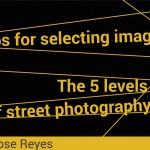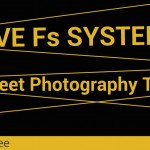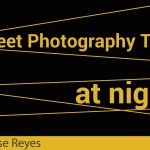How to Photograph Strangers
To Ask or Shoot | Street Photography Tips on how to shoot strangers.
Taking pictures of strangers can be intimidating.If you ask the moment may be gone, but if you don´t there may be a bigger problem. How do you decide to photograph strangers?

These girls were selling coconut jewellery at one of the surf breaks in Santa Teresa (Costa Rica). When I asked if I could take their picture they immediately got into this pose. This maybe the global effect of Facebook profile pages.
It takes some guts to grab a camera, head out in the streets, and start snapping away at complete strangers. Professional photographers at Magnum and National Geographic often spend years returning to the same spots. They study the cultures and make friends, usually to blend in more than an average person. The bags of film and memory cards connect us to places and people we may only dream of seeing. Most people who enjoy street shooting, live for these pictures. Often unrehearsed, they are the product of years of practice or sometimes dumb luck. But behind the camera, there are photographers who are constantly working up the nerve to take one more picture.
People around the world see photography differently. Nothing makes this more apparent than pointing a camera at someone. Some are natural exhibitionists and others believe, with religious conviction, that photographs are evil. Unfortunately for photographers there are no name tags declaring “I enjoy having my picture taken”. We must feel out our subjects, maybe even interact with them first, before they will allow their picture to be taken.
Over the years I have tried different ways to photograph strangers. Some were more successful than others. Luckily, there have been no disasters, just a few sour faces. To those folks, I bowed my head, apologized and moved on. It’s not worth it to press a stranger into being a model. You never know when they will exercise the right to go crazy.

I don´t speak any spanish, but this local and I both understood each other. He was speaking the universal language of relaxation. When I gestured to the camera, he cracked a little smile and waved his hand.
Asking
The hardest thing about photographing random people on the street is asking their permission. Many people have no issue being in a photograph, but they do not want to sit and wait as you meter the light, adjust the focus, or change the ISO. The settings for a shot should be done in advance. If you see someone you would like to shoot, set up your shot well before you ask them to be in your photo. It will also help the picture feel more natural.
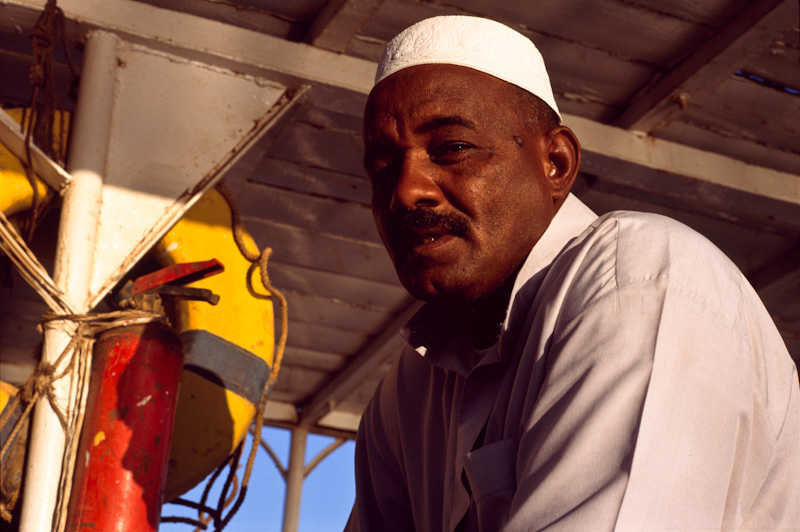
Aside from not speaking Spanish, I definitely don’t know any Sudanese. This boat captain was from Sudan, working in southern Egypt. When I showed him the camera he lifted his eye brows, as if to say, “Well as long as it doesn’t hurt too much, fire away.”
For the photographer who spends most of their time taking pictures of family and friends, they often wonder how to make the transition to strangers? They ask me “How do I ask? What do I say? What if we don’t speak the same language?” Maybe it’s like picking someone up in a bar, what do you say, “Wanna drink?” Sometimes it works, sometimes it doesn’t. There have been times when I have nodded my head with my camera in sight and the person shrugs their shoulders, permission granted. Other times I have mumbled “Photo, ok?” and they nod back. There is no formula to taking to strangers. Ideally, you should appear to have good intentions, not keep them too long (leave the tripod behind), and avoid being some lecherous creep who keeps collections of children’s photos all over the basement walls.

Leaving the hotel before sunrise, I went out for a long walk. Along the way, there was a bakery which was just opening up. The fresh pastries smelled amazing. The owner, pictured above, was delighted to offer me snacks right from the oven.
Flattery
When most people are pressed to explain how they see images on the street, they answer is “I don’t know, something just caught my eye.” You have probably said this yourself, and if not, certainly heard it countless times. Seeing the picture is step one, getting it is an entirely different challenge. If this “special something” can be put into a piece of flattery, than use it. Most people like to hear nice things about themselves. Now there are some pieces of flattery best kept quiet, these usually pertain to anatomy, striking resemblance to celebrities, and comments that sound like they could be read after misdemeanor charges in court.
However, if someone’s blue jacket happens to stand out against the yellow bench they are sitting on, there is no harm in saying, “Hey that’s a cool jacket, mind if I take your picture?” Chances are they will say yes.
Depending on the level of James Bond you have in your genes, flattery can work wonders. It is not for everyone. If you are really interested in shooting construction workers you may have to take a different approach. Calling a 250 lbs. plumber cute might not get you a photo op. There are a million different angles to work here, but the underlying premise is to find a way to make them feel comfortable for about ten seconds. Easy enough, right?
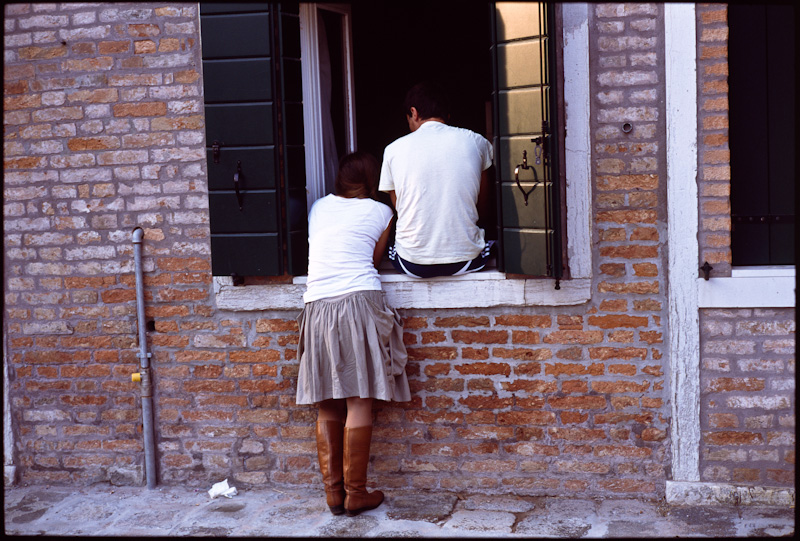
This couple was on the far side of an empty square in Venice. Once I came into the square they spotted me. But my girlfriend and I wandered around long enough that they went back to slapping each other. Eventually I pretended like I was shooting a church and backed up to them. At the last second I turned and took the picture. They never even knew I took the picture.
Distractions
Markets are one of my favorite places to shoot. There are boxes stacked on crates of new treasures waiting to be discovered and workers who look like they are right out of Marco Polo’s travels. One thing I have found about farmers, fishermen, and butchers is that they are intensely proud of their food, but often very shy. To those who are willing to pose, I always ask them for a picture. The food hanging in the backdrop works better than any professional studio. But not everyone wants to pose. They want to show the food, not themselves.
An easy way around this is a small exercise in patience. I start by taking pictures of the food. This gets them used to the click of the shutter and they usually go back to whatever they were doing. It is an old fashion photographer’s trick for loosening up nervous models. Then I adjust my focus and wait for the right moment. It is really helpful to shoot a rangefinder in this instance, because I can keep both of my eyes open. With both eyes open I can watch a scene develop and then “CLICK.” I’m done. Everyone is happy. The picture is taken and they did not have to pose. We smile at each other and go our separate ways.
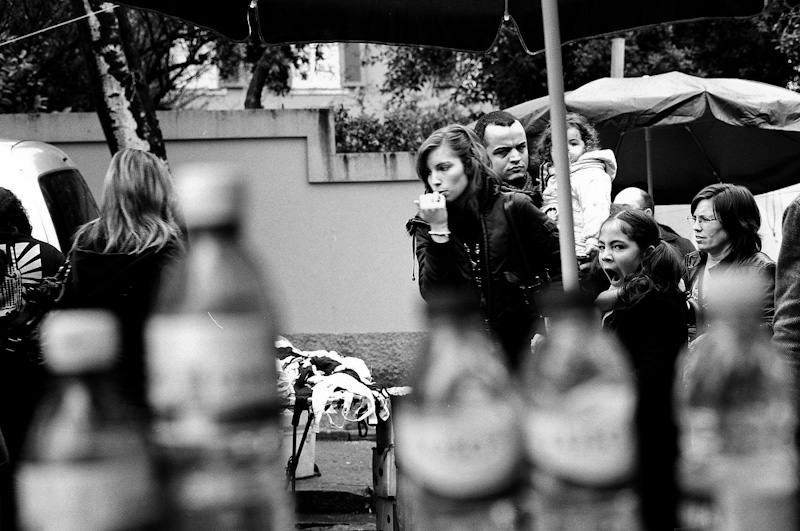
A 90mm might have made this a better portrait, but with a 50mm I can still remember peering over the wall as I walked into the market.
I might add that there is a huge difference between being shy and not wanting to be photographed. Shy translates to, “If you can get the picture, I am ok with it, but I’m not posing,” while the other is more like “If you take this picture be prepared for a fight.” Avoid the second group unless you are very comfortable with Photo-jitsu. It is also difficult to get a model release from someone after an argument or fist fight.
Stealth Street Photography
Henri Cartier-Bresson used to wish he was invisible. This way he could take pictures without people noticing him. Since the start of the 20th century we have invented some pretty high tech gadgets, but the Invisible Suit is still not on the market. As an alternative there are some simple techniques that will allow for natural looking pictures, without your subjects even knowing you were there.
HIDE YOUR CAMERA. I live in NYC and see people all the time who look like they are hunting with a camera. They carry their SLRs nearly at their face, and when they take a picture, adopt some stance that looks like it was taught at a military academy. Relax, be natural, it’s a camera not a gun. When a picture is taken nonchalantly, it does not call extra attention to you as the photographer. Then after you are finished, pull the camera away from your face. Let it hang over your shoulder or like Bresson, hold it in two hands behind your back. This famous pose, used by old men all over the world, has an understated feeling. There is no rush, there is no hurry and no one will think twice of a slow moving person who walks like a retired gentleman.
CLOSE FOCUS A FRIEND. My girlfriend and I travel everywhere together. She is like my street assistant, it’s fabulous. We got together this routine for focusing on strangers. If there is someone I want to photograph, she will either stand near them or about the same distance away in a different direction. This way I can focus on her, spin and take the picture. It’s a very good way to work if you have a travel companion. People either think I am photographing her, or they are so distracted by her walking around than by me standing still that they never notice their picture was taken.
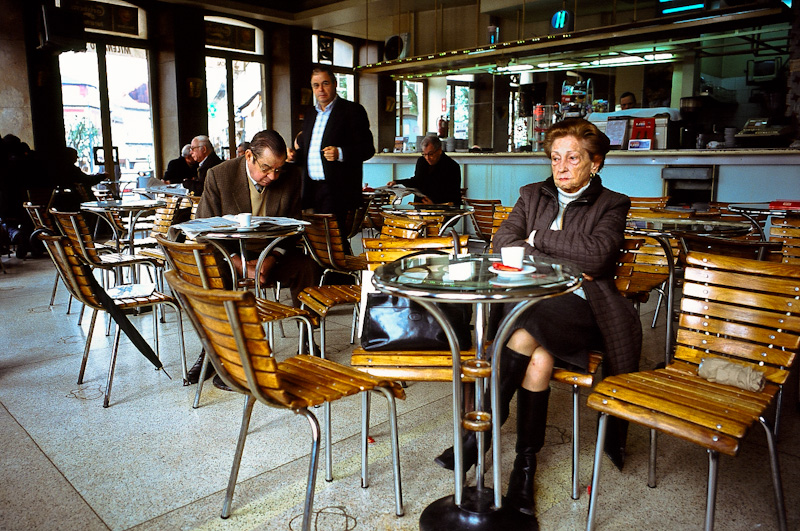
Camped out in a cafe in Guimaeres Portugal, this delightful lady came to me. Without her the picture would be incomplete.
CAMP OUT. Glass buildings can be a very useful tool for a street photographer. They act like enormous reflector shields, bouncing the sun to give an incredible fill light. When this happens, the window for opportunity can be anywhere from a few minutes to an hour. Instead of walking around looking for a picture, grab a seat, and wait for a subject to come to you. Cities are great places to shoot because there are endless streams of new people every second. Sitting on a bench could bring over a hundred potential subjects in fifteen minutes. Since you already have the lighting, the backdrop, and the feel of the picture just right, it’s easy to hang out and wait for a shot. The added advantage of waiting for a photo, rather than looking for one, is the shift in psychology that occurs. For some reason, if you are there first people act like they are intruding into your picture, instead of the inverse. This can play to your advantage. They may actually look at you as they walk by instead of ignoring you. They could be looking to see what you’re doing, they may know they are being photographed, or they may not look at all. Their behavior is easy to catch and a little “Psst,” may get their attention at exactly the right moment. Since the shot is already set up, you don’t need to have your face up to the camera. It’s a bit like the expression “Shooting fish in a barrel.”

The fisherman were just coming back from taking a few guys out on the boat. While I spoke with the little girl’s mother and father, I only ended up with a picture of her. They really like that I wanted to take pictures of the fish they caught.
Strike Up A Conversation
Of all the techniques for shooting strangers in the street, this one is the best. Going out and meeting new people is one of the great by-products of taking pictures. The stories they have may spawn a new body of work or just make for a great exchange. You never know who you will find. There are more people I meet who have stories about Leica’s than any other camera. I would never have known this had I not actually talked to them. And unless I am in a really bad area, I don’t put the black tape over the Leica label. It has been a ticket to more opportunities than I can remember, so I leave it uncovered. I wish there was a technique that could be passed along for talking to people, but there isn’t. The only thing I can say is, if you have never talked to and photographed a complete stranger, try it out. You will only have to do it once to see why it is worth overcoming the anxiety or rejection.
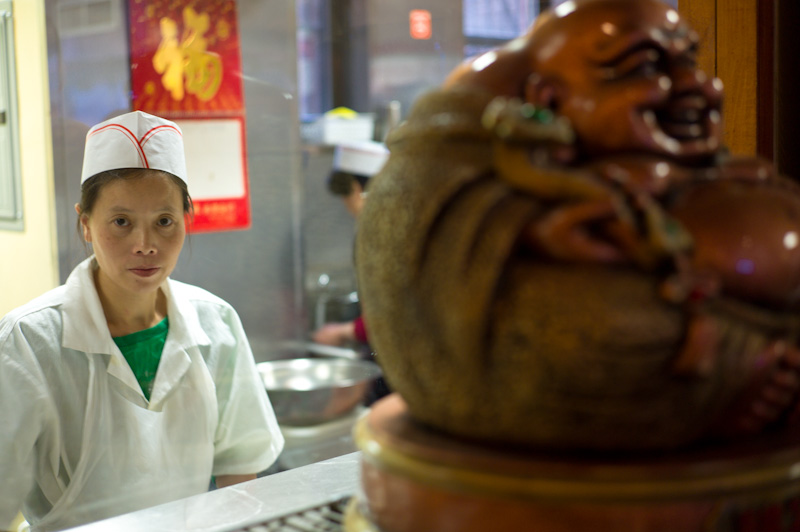
Restrooms are for customers only. Its a familiar sign at many restaurants. The advantage of buying something is that it gives you a few extra minutes to hang around and look for good pictures.
Pay for it
Getting out your wallet to take a picture may seem strange, but it’s part of the way things work. Paying for a picture could mean giving a street musician a dollar to snap a few shots or hiring a hooker in a third world country. Both are completely viable ways to get pictures. Reading the stories behind the numerous photographers who have worked in and around Red Light districts, I came to understand that many things, pictures included, are for sale. But not everyone is scouring the seedy back streets shooting hookers and pimps. Sometimes the best way to get a picture is to pay for it. Purchased images usually cost a few dollars at most. This can be particularly prevalent in third world countries. A struggling farmer is not really out of line when he asks if you can spare a dollar for a picture. Staring into the lens of a few thousand dollars’ worth of photo gear, can you really blame him? Not really. Especially if you are in a foreign country and you know there may be a few hands out for pictures, be prepared. Carry some small bills separately from your wallet. This way you are not pulling out a wallet full of money to pay someone $1.
Conclusion
Photographs are the evidence of our footsteps. They validate the path we took to find a picture. In the course of our travels, whether at home or abroad, there will be anonymous people who will pass in front of the lens. Most of them will never fully realize the role they played for us, in the development of our photography. Speaking to everyone we shoot is simply not possible. But, if we have a chance to step outside of the role as the anonymous photographer and engage the people we are shooting, the rewards are potentially endless. Good, bad, or indifferent, the mix of reactions will vary. But, with some good karma, a funny line, or just a smile we might discover something we would have otherwise missed had we not set the camera aside and said “Hi, can I take your picture?”
Source: www.adammarelliphoto.com
Find more street photography tips in our SVP-Forum
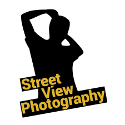
 Follow
Follow
